#Mabel Hampton
Explore tagged Tumblr posts
Text

Lillian Foster, lifelong partner of Mabel Hampton, 1942. "…When I first met her, in 1932, she was, to me … a duchess — the grand duchess — and I can't remember what she called me now. But later in life, a number of years later, I named her. I got angry with her one day and I called her the 'Little Bear' and she called me the 'Big Bear,' and of course, that hung on to me all through life. And now we're known to all our friends as the 'Big Bear' and the 'Little Bear.'" — Mabel Hampton on Lillian Foster, 1979 Source: The Persistent Desire: A Femme-Butch Reader, edited by Joan Nestle, 1992.
#original posts#mabel hampton#lillian foster#lesbian#black lesbian#lgbt poc#lesbian herstory archives#lesbian activist#femme#butch#butch femme#ofos
84 notes
·
View notes
Text
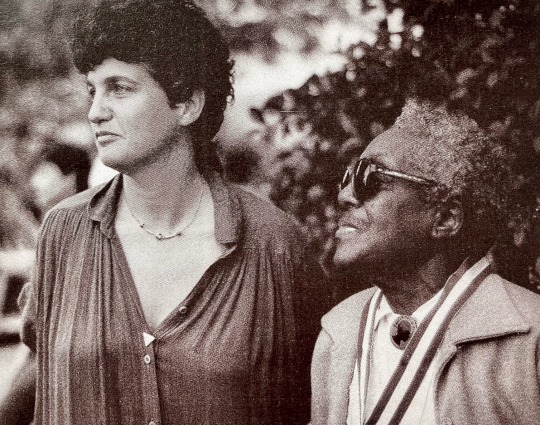
"Joan Nestle and Mabel Hampton" by Morgan Gwenwald
source: The Wild Good: Lesbian Photographs & Writings on Love, edited by Beatrix Gates
#lesbian literature#lesbian#dyke#archived#thatbutcharchivist#butch#butch dyke#butch lesbian#femme#femme lesbian#femme dyke#joan nestle#mabel hampton#black lesbian#black butch#the wild good#author: beatrix gates#photographer: morgan gwenwald#year: 1996#publisher: doubleday dell publishing group inc.#publisher: anchor books#lesbian history#black lesbian history#lesbian books#lesbian photography#lesbian elder
203 notes
·
View notes
Text

Mabel Hampton and her dog Liberation pouring over documents on the floor of the original Lesbian Herstory Archives located in Manhattan in 1977 | ph: Joan Nestle
#op#photography#mabel hampton#joan nestle#lesbian herstory archives#nyc#1970s#1977#lesbian#l#lgbt#dogs#animals
1K notes
·
View notes
Text
[“By the time Mabel arrived in 1924, Bedford was no longer the site of the tortures and abuses laid bare in a March 19, 1920, New York Tribune exposé: “Bedford Cruelty Charges Against Officials Upheld.” Not so long ago, women, Black and white alike, had been tied to their cots or handcuffed to their cell bars with their feet dangling inches above the ground. Even if Bedford had reformed, I doubt it was the good time Mabel tells Joan it was. We made whiskey. We made wine . . . We had parties there. Each night you slept with a different woman if you wanted to. Me, I was havin’ a ball. Superintendent Barker saw Bedford Hills not as a center of surveillance, the panopticon of prison we know today, but as a benevolent institution of moral reform, a safe haven away from the dangers and carnal pleasures of the city that might lead any young woman astray.
After serving seven months, Mabel was paroled with a foster family in Jersey City and worked as a domestic nearby. Bedford’s hold did not end here, though. The prison was a pipeline feeding domestic labor to well-off white ladies who lived outside the pull of New York City’s whirlwind hedonism. Mabel’s foster family reported her movements to Dr. Barker, and when she strayed into the City of Pleasure, she had to return to Bedford to continue serving her sentence. Then there was yet another domestic labor parole placement before Mabel’s discharge papers arrived in October 1926. “I do not want you to feel that our interest in you ends with the mailing of these papers,” Superintendent Barker wrote. “It is always my hope that should you at any time experience difficulties, there would be no hesitation on your part in getting in touch with the Institution.”
To Bedford Hills, Mabel was always “wild and wayward,” in need of reform. Their records are concerned only with the timeline—the dates of her incarceration and release—and the irrelevant facts they were asked to collect—a description of her nose, her IQ. An administrative accumulation we are told comprises a history.
To Joan, Mabel was an “icon,” always Ms. Hampton, an address of respect never afforded in her prison records or by the wealthy white families, much better off than Joan’s, that employed her. Joan tries to pin down the order of her hero’s journey—“And what year is this, about? We always try and do the year so people know.”—but that’s not what Mabel wants us to remember. She can hardly remember it herself. The oral history is the kind of record I crave not for its attention to dates or names or accuracy but for the dialogue. Joan asks the direct questions I wish I could have posed to Mary.
Joan’s interview style was shaped by a series of 1970s oral history workshops aimed at empowering people to record queer stories. She spent hours with friends drafting “questions that we thought would elicit the kind of history we wanted. What did you call yourself in the twenties? How did you and your friends dress in the forties? What bars did you go to?” These are not the questions of a doctor intent on diagnosis, or a sociologist intent on reform. If, for instance, W. E. B. Du Bois had drifted from 1890s Philadelphia to Mabel’s doorstep while undertaking his 2,500-household survey, he simply would have asked if she was married, single, or widowed. Joan asks instead how Mabel liked to have sex, and Mabel responds with a series of gestures, lost to us now. “They can’t see your hands,” Joan says. I imagine the middle and pointer fingers of both hands spread wide like legs, meeting at the vertices, the international symbol for scissoring. Or the same V held against her mouth, tongue poking through. But I’m getting lost in my own inventions. The Mabel I have come to know would never have been so lewd.
Joan brings to the tapes an awareness of her own bias, and a reminder of my own. She knows her presence in the room, the framing of her questions alone, shapes what comes out of Mabel’s mouth. Joan was raised by a single mother, Regina, who worked as a bookkeeper, who was let out on parole after embezzling money to provide for her daughter, and who remained poor and overworked until the day she died. “I know what it was to be marginal,” Joan says into the tape recorder, evidence that she shares some of Mabel’s working-class background. “From every eviction notice that was tacked on the door, every time the men came with flashlights to reclaim the beds or the furniture.” Still, Joan was first introduced to Mabel as the family housekeeper after Regina first met the “small black Christian woman” not at the Bronx Slave Market, street corners and intersections where Black women hoped to find a day’s work cleaning the homes of the wealthy, but at a luncheonette in Bayside, Queens. When Regina couldn’t afford the help anymore, the two women became friends and would go to the racetrack together. It was to Mabel that Regina turned when she suspected her own daughter might be a lesbian. “I’m gonna kill myself. My daughter is a lesbian,” she said. “Regina,” Mabel calmly replied. “What are you talking about? So am I. So am I.”
When Joan grew up, she developed a friendship with Mabel all her own. It was a friendship marked by question and answer, call and response, Joan’s attempts to understand the lesbians who came before and Mabel’s insistence that Joan gets her story right. “Mabel, I want to ask you a question.”
You already asked me seventy eleven! How many more you gonna ask me?“]
amelia possanza, from lesbian love story: a memoir in archives, 2023
28 notes
·
View notes
Text

Mabel Hampton- American activist and dancer
6 notes
·
View notes
Text
youtube
"Working in a cabaret frequented by lesbians, gay men, cross-dressers, and sissies, gave Mabel some elbowroom; she could move without worrying about some man on her ass. The Garden of Joy allowed her the space and time to flower into a lover of women."
from Wayward Lives, Beautiful Experiments by Saidiya Hartman
16 notes
·
View notes
Text
In the Red Summer of 1919, nothing appeared more improbable and untimely than colored girls, not yet broken by want and deprivation, dreaming of what might be possible. Despite the forty race riots that eradicated the last shreds of postwar optimism, and white folks on a killing rampage from Chicago to Texas, and black folks meeting them with violence, battling them for their lives and determined to prove, if only to one another, that freedom wasn't a mockery, and the death tables and the graphic pictures of lynched bodies published each month in The Crisis: A Record of the Darker Races, and the color line enclosing the city and solidifying the walls of the emerging black ghetto, and the inevitable servitude of domestic work and the intimate violence of hurtful things done behind closed doors, Mabel Hampton still imagined that she could live a beautiful life.
Saidiya Hartman,Wayward Lives, Beautiful Experiments
The chapter "The Beauty of the Chorus" is a thrilling account of Mabel Hampton's early days in the life in Harlem. I only recently learned of Mabel's connection to Joan Nestle. Incredible, imaginative use of the Lesbian Herstory Archives!!!
#saidiya hartman#wayward lives beautiful experiments#mabel hampton#joan nestle#lesbian herstory archives#jersey city#harlem#the crisis#red summer#1919#reading about women who survived this time gives me strength
1 note
·
View note
Text
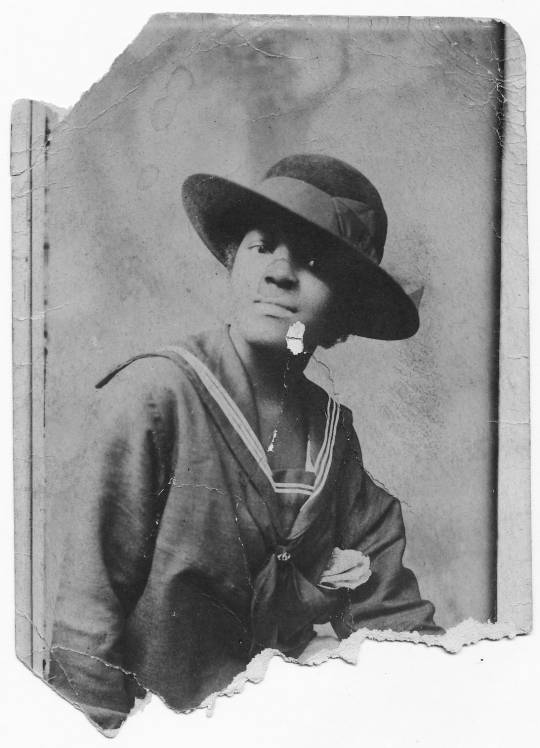

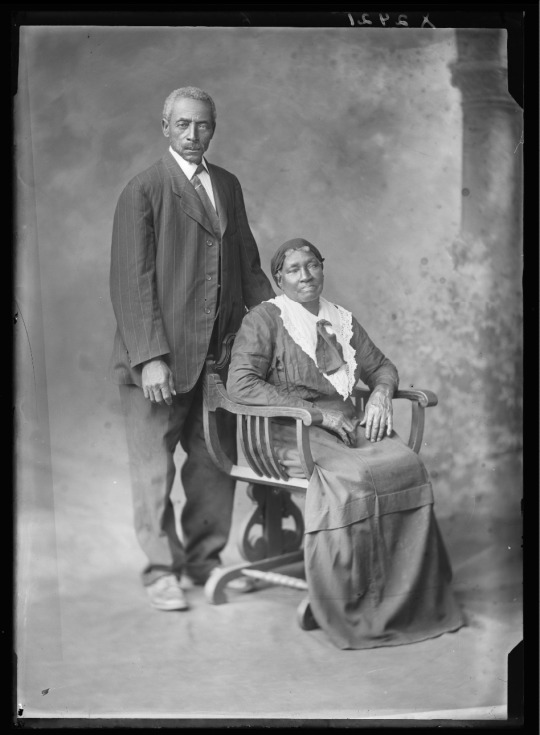
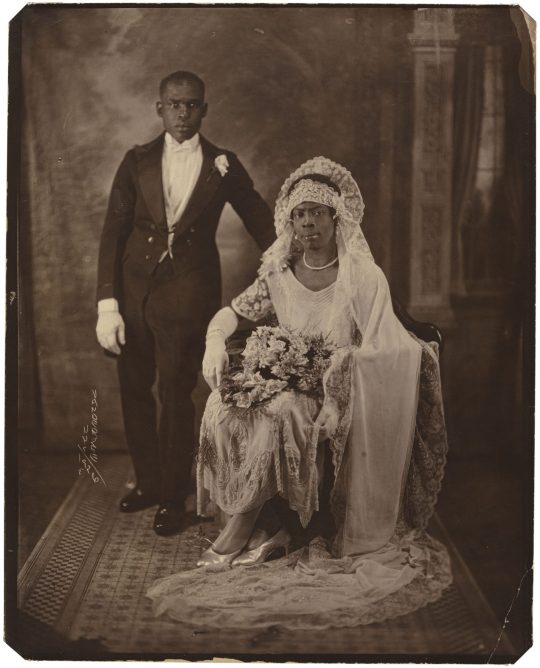
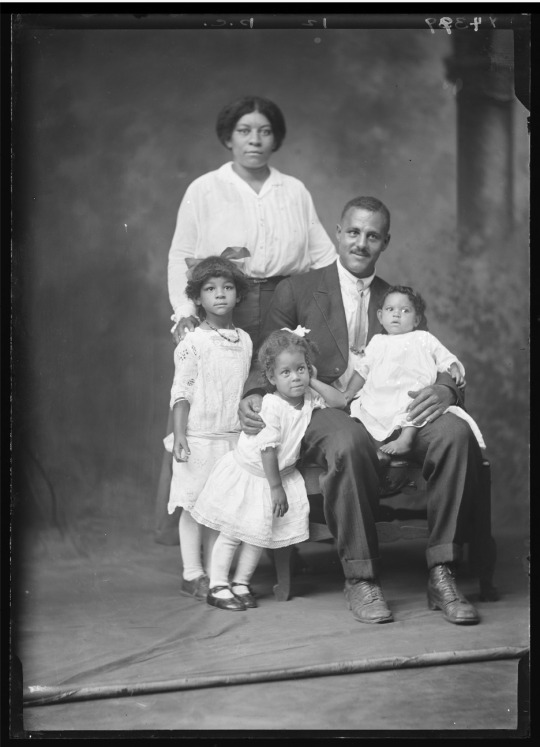
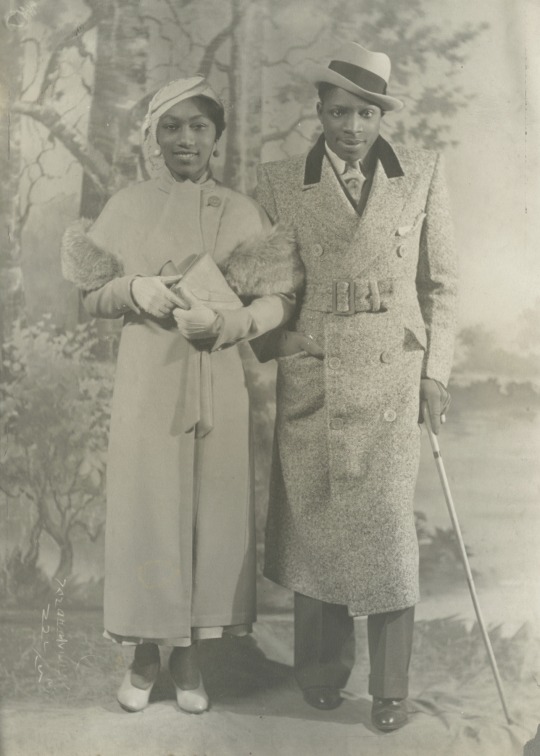


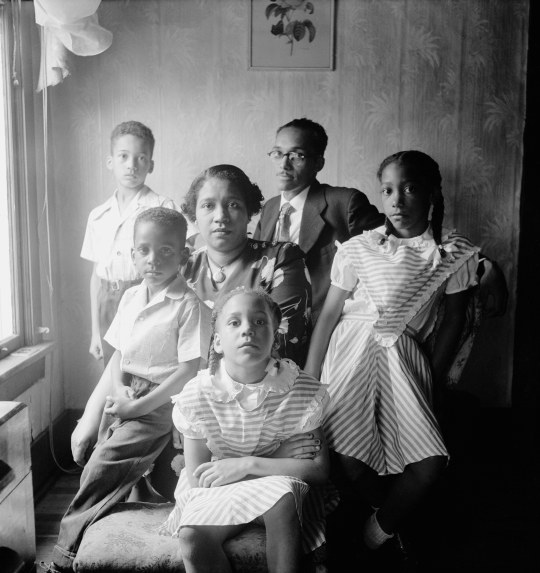

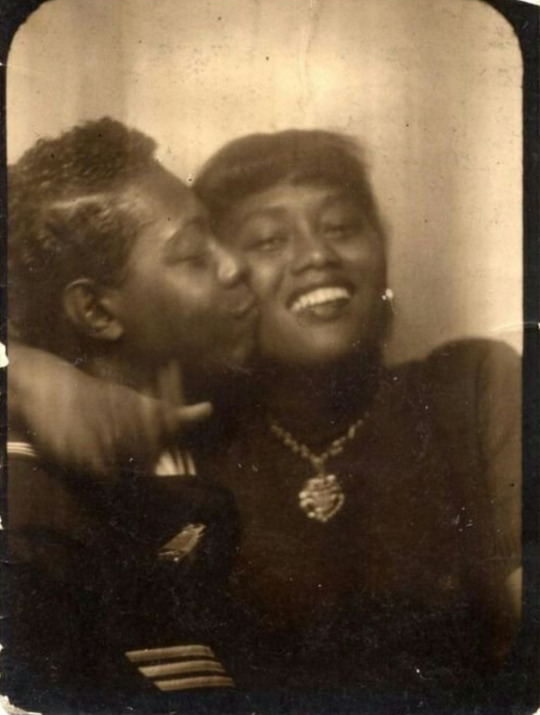

(1) Queer domestic worker and jazz lover Mabel Hampton (1919)
(3) Annie Bell and Sammie Pratt (1905)
(4) Mr. and Mrs. Joe Spears (1914)
(5) Bride and Groom (1926)
(6) William Biggers and his family (1916)
(7) A well-dressed couple strolling together (1925)
(8) A stylish New York couple in Harlem (1932)
(9) Lorraine Hurdle, a Black lesbian, posed in her United States Women’s Army Corps (WAC) uniform alongside a bespeckled lady friend during World War II
(10) A Family Portrait in Fort Scott, Kansas (1950)
(11) The wedding of transgender essayist Dawn Pepita Hall and her husband, auto-mechanic John Paul Simmons (1969)
(12) A couple shares a kiss inside a photo booth (1930s-40s)
(13) Two men share a kiss under a tree (1977-78)
Special Love to the Holsinger Collection, KyKy Archives, James Van Der Zee Studio, Mabel Hampton Collection, and the National Museum of African American History and Culture
#for my afrofolio of period dramas#black history month#black people are everywhere#always have been#valentine's day#our history is your history#queer topics
159 notes
·
View notes
Photo
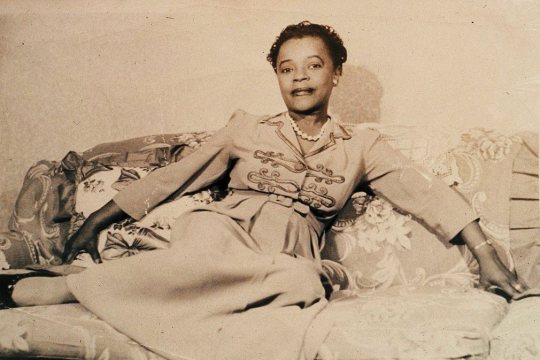
Lesbian Heroes 🏳️🌈
Mabel Hampton (May 2, 1902 – October 26, 1989)
“I have been a lesbian all my life, for eighty-two years, and I am proud of myself and my people. I would like all my people to be free in this world, my gay people and my black people.” – Mabel Hampton (New York Pride 1984)
Mabel Hampton was born in 1902. She was a Black lesbian activist, dancer and philanthropist. Born in Winston-Salem, North Carolina, Hampton was only two months old when her mother died. She was raised by her grandmother and then by her aunt and uncle, who treated her badly. From the age of eight to 17, Hampton lived with a white family in New Jersey. In 1919 she went to jail for prostitution, which she saw as a lesbian code. After serving 13 months of a three-year sentence at Bedford Hills, Hampton was released. In the 1920s, Hampton danced in all-black productions alongside the stars of the Harlem Renaissance. In 1932 she met Lillian Foster and the two women began a relationship that lasted until Foster's death in 1978. Throughout the 60s, Hampton was the central figure in a black lesbian community that flourished in the Bronx, and in 1974 she began working with the Lesbian Herstory Archives. Mabel was also an important person in the gay rights movement - she participated in every gay pride march during her lifetime, including the first historic march and demonstration for gay rights in Washington, D.C., in 1979. In 1985, Mabel was named Grand Marshal of the New York City Gay Pride March. In the same year, Mabel received a lifetime achievement award from the National Coalition of Black Lesbians and Gays. Interviews with Mabel are featured in the movies „Before Stonewall“ and „Silent Pioneers“, both of which document the struggle for gay rights and efforts to achieve equality. Mabel died of pneumonia in 1989 in New York, USA, at the age of eighty-seven.
#lesbian books#ylva publishing#ylva blog#lesfic#lgbt books#wlw books#sapphic books#queer books#lesbian history#queer history
126 notes
·
View notes
Photo
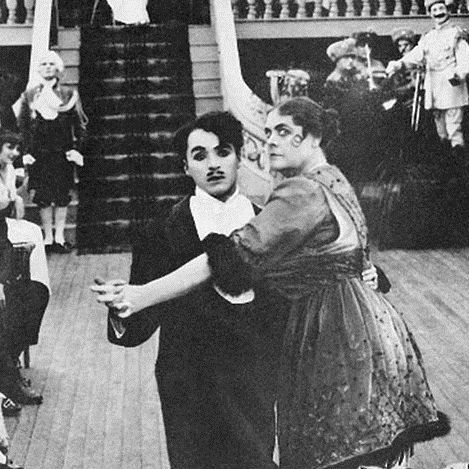
Charles Chaplin and Marie Dressler in Tillie's Punctured Romance (Mack Sennett, 1914)
Cast: Marie Dressler, Charles Chaplin, Mabel Normand, Mack Swain, Charles Bennett, Chester Conklin. Screenplay: Hampton Del Ruth, Craig Hutchinson, Mack Sennett, based on a play by A. Baldwin Stone and Edgar Smith. Cinematography: Hans F. Koenekamp, Frank D. Williams.
Tillie's Punctured Romance was Mack Sennett's first venture into feature-length production, and perhaps the first feature-length comedy ever made. Despite the later reputation of Charles Chaplin, it was designed as a starring vehicle and film debut for Marie Dressler, then the much bigger star. It was adapted from her Broadway hit, Tillie's Nightmare, and Dressler claimed that she persuaded Sennett to cast Chaplin as her leading man. Adding Sennett's then-lover Mabel Normand, who also had a hand in developing Chaplin's early career, created a wonderful dynamic, but the teaming was never repeated: Chaplin's ambitions led him into writing and directing his own films; Normand and Sennett split in 1918, and her career suffered from her drug addiction and association with director William Desmond Taylor, whose murder in 1922 caused a scandal; Dressler was unable to establish a film career after the failure of two short films in which she also played Tillie, though she returned to the screen in 1927 after a nine-year absence. It's a shame, because Dressler was one of the few comic actresses capable of upstaging Chaplin, as their scenes together demonstrate. She had a rare gift for over-the-top physical comedy, which was Sennett's forte. For this anarchic comedy, he marshaled all of his regular company, including Mack Swain and Chester Conklin, as well as the Keystone Kops, without ever eclipsing Dressler. Later in her career, Dressler would evoke pathos as well as laughs, but Sennett never lets Tillie be anything but a clown, except at the very ending, when she and Mabel share in their triumph over Chaplin's con man.
7 notes
·
View notes
Text

"Mabel Hampton at the Lesbian Herstory Archives, New York, 1978" from the Mabel Hampton Special Collection, Lesbian Herstory Archives
source: The Persistent Desire: A Femme-Butch Reader, edited by Joan Nestle
#lesbian literature#lesbian#dyke#archived#thatbutcharchivist#butch dyke#butch#butch lesbian#black lesbian#black lesbian history#black butch#mabel hampton#lesbian herstory archives#the persistent desire#author: joan nestle#mabel hampton special collection#year: 1992#publisher: alyson publications inc.#poc lesbian history#lesbian history#lesbian books#old lesbian#lesbian elder#lesbian photography#black sapphic#black history
84 notes
·
View notes
Text

Harlem Renaissance singer/dancer and lesbian activist Mabel Hampton photographed alongside her lifelong partner Lillian Foster. During their 46 year relationship, they referred to each other as husband and wife. | c. 1940s
#op#photography#mabel hampton#lillian foster#couples#lesbian couples#lesbian#lgbt#female husbands#1940s#wlw#lbtq#idk what my tagging system is anymore i should fix tht sometime huh
338 notes
·
View notes
Text
[“Once, Joan took up the microphone for a solo performance that fills up an entire B side. She was sick. Her head hurt too much to write. Doctors couldn’t diagnose her. She worried she was coming to the end of her life and wanted to leave a final message. “I want to tell tales of a lesbian life,” she says, her voice high and self-conscious where Mabel’s is deep and restless. “I want to talk about the wonderful women I’ve known, and I want to talk about what it’s meant to be a lesbian and how it was at the core of all I think that was best in me.”
When Joan sat down to record this tape, she had already begun to collect tales of the wonderful women and lesbians she had known. In 1974, she cofounded the Lesbian Herstory Archives with Mabel Hampton and two other women dedicated to preserving lesbian culture before it disappeared. A year later, the budding collection of letters, magazines, cassettes, photographs, and books took up residence at Joan’s Upper West Side apartment, where it would continue to grow for the next fifteen years, until the organization raised enough money to purchase a permanent home, a brownstone in Park Slope. Mabel was a fixture at the archives, regaling volunteers with stories of the Harlem Renaissance as they opened the mail.
Joan lived. She went on to record dozens more interviews with Mabel for the archive. Their relationship marked a fundamental shift in how lesbian history was set down and passed along. Until Joan and Mabel, the amateur sexologists who edited Mary Casal’s memoir, the police who arrested women in male garb and the courts who put them on trial, and the newspaper editors who reduced their stories to lurid headlines filtered lesbian stories through the gaze of authority.
Sheer accident preserved much of what we know, what I can know, about the lesbians who lived at the turn of the century. Their personal letters and pages of poetry left a record so riddled with holes it leaves room to either imagine lesbian stories or discount them entirely. “]
amelia possanza, from lesbian love story: a memoir in archives, 2023
62 notes
·
View notes
Text
OBIT: Keith Speicher
May 10, 1950 ~ January 7, 2025 Keith Speicher age 74 of Fredericksburg, IA died Tuesday, January 7, 2025, at Floyd County Medical Center in Charles City, IA. A Celebration of Life will be held at a later date. Keith Charles Speicher, known affectionately as “Spike” to his friends, was born on May 10, 1950, to Leo and Mabel Ungerer Speicher in New Hampton, Iowa. He passed away peacefully on…
0 notes
Text

Delores Briggs Forehand joined the Heavenly choir of angels on April 25, 2023 at the age of 95. Born in Portsmouth, Ohio in 1927 to parents George and Mabel Briggs. Delores was predeceased by her parents; husbands, Firman Cuthriell, Jr. and Willis Weymouth Forehand; and son, Terry Wayne Cuthriell.
She is survived by her daughter, Denise Yvonne Forehand and her children, Jessica, Travis and Brett; a daughter-in-law, Deborah Cuthriell and her children, Christopher, Rachel, Sarah, and Hannah; 19 great-grandchildren from both families; a loving sister, Nancy Carolyn Briggs Vaughan; nieces, Debbie, Donna and great-niece, Kaleigh Mabel; and a nephew, Tom Forehand.
Delores was a graduate of Deep Creek High School and Bob Jones University. She pursued music studies at Southern Baptist Seminary. Her voice teacher, Nora Reynolds, was a great friend and mentor.
Delores was a pioneer in Christian Broadcasting when it began as WYAH-TV in the 1960s and appeared weekly on her own program for 8 years. She recorded several albums and her music can be found world-wide on Amazon and Spotify. She served as director of music and education in North Carolina and Virginia.
Delores was a long-time active member of Deep Creek Baptist Church in Chesapeake and loved teaching God's word and singing sacred music. She was truly loved by her family and so many friends within the Deep Creek community.
Funeral services will be held at Deep Creek Baptist Church on Saturday, April 29, at 1 p.m. The family will receive friends the hour before the service at the church. Burial will follow in Olive Branch Cemetery. In lieu of flowers, please donate to the Foodbank of South Hampton Roads. Sturtevant Funeral Home, Portsmouth Blvd. Chapel is assisting the family.
#Bob Jones University#BJU Hall of Fame#2023#Obituary#BJU Alumni Association#Class of 1948#Delores Briggs Forehand
0 notes
Text
10/24 おはようございます。Gwen Guthrie / Hopscotch dmd640 等更新しました。
Linda Ronstadt / What’s New 60260 Mabel Mercer / Once In A Blue Moon 1301 Ella Fitzgerald Count Basie / Metronome All Stars 1956 Mgc743 Anita O'day / Sings the Winners Mgv8283 Anita O'Day / Swings Cole Porter with Billy May Mgv2118 Lynn Mariano Frank Cunimondo trio / Introducing Lynn Mariano m1038 Ann Burton / Blue Burton Mdjs3063 Myrna Fox / Mmmmm Myrna Lrp3050 Slide Hampton / Somethin' Sanctified sd1362 Milt Jackson / Bags Opus ual4022 Mingus Dynasty / Live at Montreux sd16031 Johnny Rae / Herbie Mann's African Suite ual4042 Herbie Mann / Brazil Bossa Nova & Blues uaj14009 Gerry Mulligan Stan Getz / Getz Meets Mulligan T587/MGV8249 Pat Martino / the Visit Cst9015 Omni / Out of My Hands - long version frd81-1 Michael McGloiry / Won't You Let Me Be the One aw12-94964 Richard Jon Smith / Baby's Got Another VJ12012 Sylvia / Lay it On Me - Stop vid1 Gwen Guthrie / Hopscotch dmd640
~bamboo music~
530-0028 大阪市北区万歳町3-41 シロノビル104号
06-6363-2700

0 notes